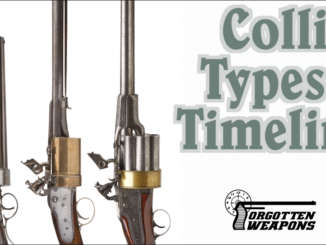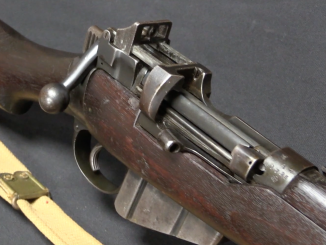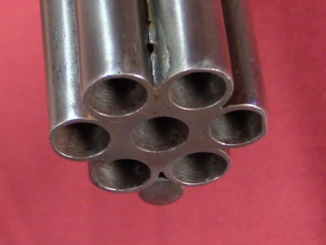This is Lot 1127 in the upcoming October 2019 Morphys Extraordinary auction.
During World War One, the Ottoman Empire would join the war on the side of the Central Powers, in part because of a decision by the British Navy to seize a pair of battleships under construction for the Ottomans in the UK. This also caused the Ottoman military to adopt the 1909 Maxim as their standard machine gun, purchasing them from DWM in Germany. Once commercial sales ended in 1916, they would continue to use German MG08 and MG08/15 machine guns provided as military aid.
When World War Two broke out, England (and Winston Churchill personally) very much wanted to avoid a repeat of the the previous war. In an effort to build an alliance with Turkey, they provided nearly 1200 like-new refurbished Vickers machine guns to Turkey.
The Turks had outfitted their previous inventory of Maxims with an assortment of accessories, and these were added to the new Vickers guns. In addition to being rechambered for the 8x57mm Mauser cartridge, Turkey added antiaircraft sights, ZF12 optical sights, and MG 08/15 drum brackets, and completely rebuilt the tripods to make them more stable and add antiaircraft capability.




Turkey stayed neutral in WWII, a situation that possibly suited both sides, until February 1945 when it declared war on the Axis powers. The article I just looked at mentions not Vickers guns but 25,000,000 Pounds Sterling (!) of military credit authorized by Parliament in September 1939, before Churchill became Prime Minister (though at that time he was First Lord of the Admiralty). If these Vickers guns were refurbished in Belgium that work had to be done before May of 1940, a very small historical window.
“(…)Turkey stayed neutral in WWII, a situation that possibly suited both sides, until February 1945 when it declared war on the Axis powers.(…)”
Yes, here: https://www.jstor.org/stable/24450672?seq=1#page_scan_tab_contents it is said that:
(…)president of Turkey(…)’s two guiding principles in foreign affairs were caution and balance(…). Balance did not equal neutrality, but rather a recognition that Turkish interests would be served best by a balance of power in Europe, through which the Great Powers would each serve as a check on the ambitions of the others.(…)”
I am sure that when the Home Guard were parading with broomsticks in 1940, they were delighted that Turkey had 1200 Vickers guns.
At that point, even the horrible Ross Mark 3 from Canada (if any were around) looked like a better option than a broom. No downed German airmen were intimidated into surrendering by broomstick-wielding civilians. Just kidding!
Pitchforks, on the other hand…
😉
cheers
eon
Okay, I’ll give you overly sharpened farm tools. One lesson learned from the Battle of Crete was that having ALL your paratroops’ guns stashed in the parachuted weapons canister was a bad idea, especially as the majority of parachuting soldiers came down with only a single bayonet or pistol for personal use. Several fallschirmjägers were literally butchered alive by angry Cretans armed with axes, shovels, and pruning sickles… I hope I’m wrong.
I dont believe it.
To Storm: Good, you didn’t believe it. I suppose you didn’t know that the heaviest weapon a paratrooper could carry on his person without having it ripped away during a drop was a sub-machine gun strapped to his uniform. Until the M1 Carbine showed up, all long arms were to be stored in canisters that would accompany paratroopers to the drop zone. We assume the wind doesn’t blow the canister away or that the canister doesn’t get destroyed by flak in the meantime.
In Len Deighton’s book about the Battle of Britain, there is a photograph of a German airman being taken prisoner by REGULAR army soldiers. Deighton points out that it was incredibly strange that the picture was released to the newspapers. At least one soldier is in WWI era uniform, and the only man with a rifle is carrying a Ross.
Probably not a good idea to give any German reader an idea of how badly the equipment loss in France was affecting the Army after Dunkirk.
Everyone should read more Len Deighton, both his 1960’s spy novels and his military history. He accumulates wonderful details about the intersection between politics, economics, and military activity.
His comments on handguns in the “man from Burnley” aka “Harry Palmer” novels are priceless.
In The Ipcress File, Deighton’s nameless spy (but let’s call him Palmer anyway) was issued a Smith & Wesson Bodyguard .38 Special snub, five-shot. He was also issued two “spare cylinders” (speedloaders) of .38 Special ammunition. These were six-cartridge drum-type devices, apparently originally made for use with the Enfield and Webley Mk IV revolvers in 0.380in aka .38 S&W.
Naturally, they did not fit the five-shot S&W Bodyguard.
To make matters worse, since the .38 Special cartridges fit rather loosely in the loaders designed for the shorter, fatter .38 S&W rounds, to keep them from falling out they were heavily greased to “stick” them in the loaders.
Quite aside from the unintentional and dangerous “hilarity” of trying to pluck individual rounds from such a loader with your fingers to reload the revolver, probably in the dark and under fire (catching the proverbial greased pig wouldn’t even be in it), there are the small issues of what the grease does to the primers, and of course what happens when a heavily lubricated, straight-wall cartridge is fired in a straight-sided chamber.
By the time of Funeral in Berlin, they had replaced the .38 revolvers with 9mm FN (P-35 HP) pistols. Probably a good idea, especially if they refrained from greasing the cartridges to keep them from “falling out” of the magazine.
Keep in mind that Deighton was a Foreign Office employee, who had been all over the former Empire and knew the bureaucracy well, including the intelligence agencies. So when he said that they did something stupid, there’s an excellent chance he was just reporting what he actually saw.
cheers
eon
“(…)Ottoman Empire would join the war on the side of the Central Powers, in part because of a decision by the British Navy to seize a pair of battleships under construction for the Ottomans in the UK.(…)”
Ah, yes HMS Agincourt – with 7 turrets of main artillery. Was it quite perplexing, apparently their naming convention for 7 turrets names was totally different than 4 turrets – that is Sunday, Monday and so on as opposed to A, B, X, Y.
Anyway, I think SMS Goeben history should be not ignored, after dash through Mediterranean Sea it was declared to be Ottoman ship Yavuz Sultan Selim. Then its sail to Black Sea and fired and Sevastopol, even though it was at territory which was NOT in state of war against Ottoman Empire. In response Russian Empire declared war to Ottoman Empire
A very fun adventure/spy novel about Germany and Turkey in the first world war is Green Mantle by John Buchan later governor general of Canada. Some very pithy statement about the muslim world that sound modern
Though not exported on the scale of some others (not for want of trying by Vickers – at every possible opportunity). Not inconsiderable numbers sold and batches appear in numerous places / countries worldwide. Notably Italy – perhaps as many as 750 pre WWI (before it adopted the ‘interesting’ Revelli), China, Japan etc.
1. Storm, Cherndog is right, the design of German parachute and the door of the Ju-52, made a holstered pistol all a fallschirmjager could carry on a jump,submachine guns, rifles and heavier were dropped in containers.
“Fallschirmjäger dropped into combat armed only with a pistol and their knife. Upon landing they were expected to dash to drop containers which had been parachuted down along with them. There the would recover thier fighting weapons, grenades and other items with which to carry out the mission.”
http://fallschirmjager.net/Vehicles/DropCanister/index.html
The US Army developed rifle and carbine cases that could be strapped to the body. This is a postwar paratrooper, but his weapons bag is in the center and the the left hand figure has it strapped to his left leg.
https://i.pinimg.com/originals/ce/ac/f6/ceacf61878f6d68cb001179840ce2238.jpg
2. Daweo,yes HMS Agincourt, originally ordered by the Brazilians who sold the incomplete hull to the Ottomans. It’s 7 main battery turrets and 14 twelve inch guns were all time records. The legend in the RN was she was so lightly built that if she fired a broadside, she’d sink herself. This was put to rest by Jutland where she fired full broadsides, amazing all who beheld the spectacle. One witness said she looked “like a battlecruiser blowing up”
https://en.wikipedia.org/wiki/HMS_Agincourt_(1913)
The other ship seized under Right of Angary (https://en.wikipedia.org/wiki/Angary) was HMS Erin, with ten 13.5-inch guns
https://en.wikipedia.org/wiki/HMS_Erin